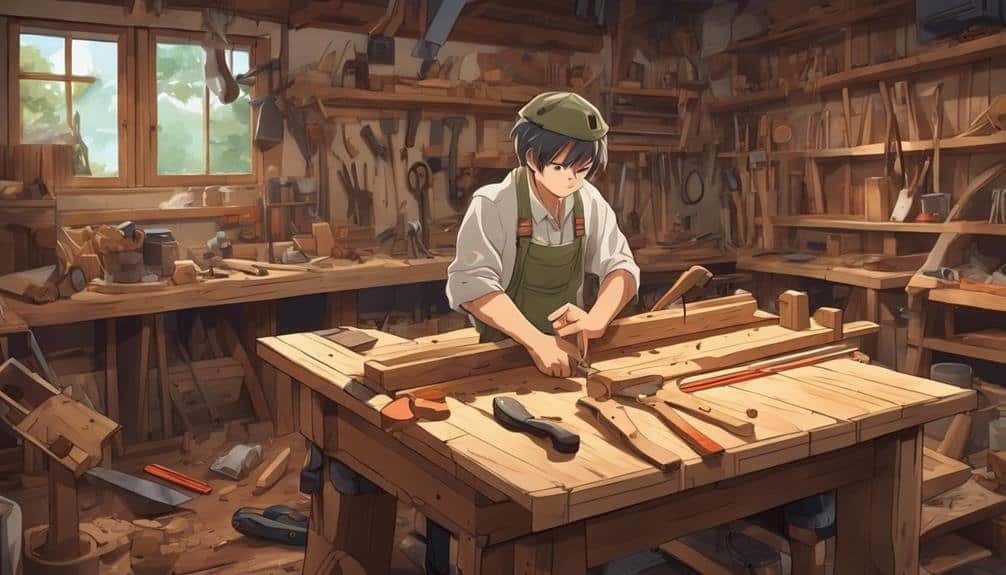Job Duties for Carpenter
Carpenters play a vital role in the construction industry, utilizing their skills and expertise to bring architectural designs to life. From meticulously cutting and shaping wood to collaborating with the construction team, their job duties are varied and essential for the successful completion of a project.
However, there is more to being a carpenter than meets the eye. The intricacies of their craft go beyond mere woodworking, encompassing a blend of precision, creativity, and problem-solving abilities that set them apart in the domain of construction.
Key Takeaways
- Precision cutting and shaping wood for intricate designs with attention to detail.
- Expertise in installation and repair of structures using specific techniques and tools.
- Accurate measurement and blueprint interpretation for project coordination and planning.
- Efficient collaboration with construction team for clear communication and project management.
Wood Cutting and Shaping
Engaging in precise wood cutting and shaping is a fundamental aspect of a carpenter's job duties, requiring both skill and attention to detail. Wood carving is a specialized technique that carpenters often use to create intricate designs and patterns on furniture pieces. This process demands patience and a steady hand to bring out the beauty of the wood.
In furniture making, carpenters must carefully measure and cut wood to construct tables, chairs, cabinets, and other items. They need to understand the properties of different types of wood to confirm the durability and quality of the final product. Carpenters also use various tools such as saws, chisels, and sanders to shape the wood according to the desired specifications.
Attention to detail is important in wood cutting and shaping to guarantee that each piece fits together seamlessly during the assembly process. Carpenters take pride in their craftsmanship, knowing that their precision and expertise will result in well-crafted furniture pieces that stand the test of time.
Installation of Structures
When it comes to the installation of structures, carpenters must be well-versed in utilizing a variety of tools to guarantee precise and secure placement.
Additionally, strict adherence to safety measures is paramount to prevent accidents and injuries during the installation process.
Mastery of these tools and safety protocols is essential for carpenters to execute their duties effectively and efficiently.
Tools for Installation
Utilizing a diverse array of specialized tools is essential for the precise and efficient installation of structures by carpenters. To ensure seamless operations, carpenters must prioritize tool maintenance and stay updated on the latest installation techniques.
Here are three key tools vital for installation:
- Power Tools: Electric saws, drills, and nail guns are indispensable for cutting and fastening materials swiftly.
- Measuring Instruments: Tools like tape measures, levels, and squares guarantee accuracy in dimensions and angles during the installation process.
- Fastening Tools: Hammers, screwdrivers, and wrenches are vital for securely fastening structural elements together.
Safety Measures Required
Implementing rigorous safety measures is paramount during the installation of structures to guarantee the well-being of carpenters and the successful completion of projects. Carpenters must always wear appropriate safety gear such as hard hats, gloves, and safety glasses. Proper training on how to safely handle tools and equipment is paramount to prevent accidents. Before starting any installation, a thorough hazard assessment should be conducted to identify potential risks, and necessary precautions should be implemented accordingly. This proactive approach guarantees a safe working environment for all workers involved in the project. By prioritizing safety through the use of safety gear, training, hazard assessment, and precautions, carpenters can mitigate risks and contribute to the successful execution of installation tasks.
| Safety Measures | Description |
|---|---|
| Safety Gear | Hard hats, gloves, safety glasses |
| Training | Proper handling of tools and equipment |
| Hazard Assessment | Identify potential risks |
Repairing Damaged Fixtures
When it comes to repairing damaged fixtures, carpenters must be adept at various types of repairs. This can range from fixing broken cabinets to repairing damaged door frames. Utilizing a range of tools and materials such as hammers, saws, wood glue, and sandpaper is essential in executing these repairs effectively.
Understanding the specific techniques and methods for each type of repair guarantees that the fixtures are restored to their original functionality and appearance.
Types of Repairs
As a carpenter, one of the essential job duties involves proficiently repairing damaged fixtures to guarantee structural integrity and aesthetic appeal. When it comes to repairing damaged fixtures, carpenters are skilled in various types of repairs, including:
- Furniture restoration and custom designs: Carpenters excel in restoring old or damaged furniture pieces to their former glory, often incorporating custom designs to meet client preferences.
- Exterior and interior repairs: Carpenters are proficient in repairing both exterior and interior fixtures, ensuring that the structural elements of a building are sound and visually appealing.
- Structural repairs: Carpenters are experienced in addressing structural issues such as damaged support beams, sagging floors, or unstable staircases, providing solutions that enhance safety and longevity.
Tools and Materials
To effectively carry out repairs on damaged fixtures, carpenters rely on a specific set of tools and materials tailored to address a variety of structural issues and guarantee long-lasting results. Tool maintenance plays a critical role in ensuring that the equipment is in best condition for use. Carpenters must regularly inspect, clean, and lubricate their tools to prevent malfunctions and accidents.
When selecting materials for repairs, carpenters consider factors such as durability, strength, and compatibility with existing fixtures. Safety precautions are paramount during the repair process to protect both the carpenter and the property. Additionally, tool efficiency is key to completing repairs efficiently and accurately.
Reading and Interpreting Blueprints
Understanding how to read and interpret blueprints is a critical skill for carpenters to guarantee the precise execution of construction projects. Blueprint interpretation is essential for accurate construction planning, enabling carpenters to grasp the layout, dimensions, and materials required for the project. This skill also involves design comprehension, allowing carpenters to visualize the final structure based on the blueprint specifications. Additionally, proficiency in blueprint interpretation enhances project coordination by guaranteeing that all team members are on the same page regarding the construction details and timeline.
- Accurate Construction Planning: Reading blueprints accurately helps in planning the construction process efficiently.
- Visualizing Design: Interpreting blueprints enables carpenters to visualize the final design and make necessary adjustments before starting the project.
- Enhanced Project Coordination: Clear blueprint interpretation fosters better coordination among team members, leading to smoother project execution.
Measuring and Marking Wood
Proficiency in accurately measuring and marking wood is a fundamental skill that guarantees precision and consistency in carpentry projects. Woodworking techniques require precise measurements to make sure the final product meets specifications. Carpenters often use various tools such as tape measures, rulers, squares, and levels to mark and measure wood accurately.
| Tools | Description | Usage |
|---|---|---|
| Tape Measure | Flexible ruler for length | Measure boards and dimensions |
| Square | Right-angle tool | Mark straight lines and corners |
| Level | Ensures horizontal/vertical | Align pieces during assembly |
| Ruler | Straight edge measuring | Guide for accurate cuts |
| Marking Knife | Sharp tool for scoring wood | Create precise cut lines |
Wood surface treatment and finishing touches often depend on accurate measurements and markings. Whether cutting pieces for furniture or framing a structure, attention to detail guarantees a professional result. Carpenters must master these skills to execute projects effectively and efficiently, meeting quality standards in the woodworking industry.
Operating Power Tools Safely
When utilizing power tools in carpentry, prioritizing safety measures is paramount to confirm a secure working environment and prevent accidents. Operating power tools safely requires a combination of tool maintenance and adherence to safety precautions. Here are three essential aspects to take into account:
- Regular Tool Maintenance: Proper maintenance of power tools is critical to guarantee their safe and efficient operation. This involves checking for any damage, keeping blades sharp, lubricating moving parts, and following manufacturer guidelines for upkeep.
- Safety Precautions: Prior to using any power tool, it is essential to wear appropriate personal protective equipment (PPE) such as safety goggles, hearing protection, and gloves. Additionally, always unplug tools when not in use, never carry a tool by its cord, and keep the work area well-lit and clutter-free to prevent accidents.
- Training and Familiarity: Before operating a new power tool, carpenters should read the user manual thoroughly, attend training sessions if available, and practice using the tool in a controlled environment to ensure confidence and competence in its operation.
Finishing and Sanding Surfaces
To achieve a smooth and professional finish on carpentry projects, mastering the art of finishing and sanding surfaces is essential. Surface preparation is important before applying any finish. This involves ensuring the surface is clean, free of debris, and properly smoothed. Different finishing techniques such as staining, painting, or varnishing can be used to enhance the appearance and protect the wood. When it comes to sanding, using the correct grit sandpaper is essential. Coarse grits are suitable for removing material, while finer grits are best for achieving a smooth finish. It's important to sand in the direction of the wood grain to prevent scratches. Additionally, refinishing methods can be applied to restore old or damaged surfaces to their former glory. Here are some sanding tips and refinishing methods summarized in the table below:
| Sanding Tips | Refinishing Methods |
|---|---|
| Use the right grit | Stripping old finish |
| Sand with the grain | Staining |
| Check for smoothness | Varnishing |
| Remove dust between coats | Applying protective coatings |
| Use sanding blocks or tools | Repairing scratches or dents |
Maintaining Carpentry Tools
Maintaining the proper maintenance of carpentry tools is paramount to prolonging their lifespan and optimizing their performance. Proper tool maintenance not only enhances the efficiency of the tools but also contributes to the safety of the carpenter and those around them.
Here are three key practices for maintaining carpentry tools:
- Regular Cleaning: After each use, it is essential to clean the tools thoroughly to remove any debris or buildup that could affect their performance. This simple practice can prevent rust and corrosion, ensuring the longevity of the tools.
- Proper Storage: Storing carpentry tools in a dry and secure location helps prevent damage and maintains their sharpness. Tools should be stored in a toolbox or on a pegboard to keep them organized and easily accessible.
- Routine Inspections: Regularly inspecting tools for signs of wear and tear allows for timely repairs or replacements. This practice ensures that the tools remain in best condition, promoting safety and efficiency in carpentry tasks.
Collaborating With Construction Team
Collaborating effectively with the construction team is essential for ensuring project success and efficient workflow coordination. Team collaboration and project management are key aspects of a carpenter's role when working on construction projects. Clear communication skills and problem-solving abilities are critical for fostering a productive work environment and overcoming challenges that may arise during the construction process.
To excel in collaborating with the construction team, carpenters must effectively communicate project requirements, timelines, and any potential obstacles. They need to work closely with other tradespeople, such as electricians and plumbers, to ensure that all aspects of the project align seamlessly. Additionally, problem-solving skills are critical for addressing unexpected issues and finding practical solutions to keep the project on track.
| Skills Required | Description | Importance |
|---|---|---|
| Communication | Clear and concise interaction with team | High |
| Team Collaboration | Working together towards project goals | Essential |
| Problem Solving | Finding solutions to challenges | Critical |
| Project Management | Organizing tasks and resources efficiently | Key |
Conclusion
To sum up, carpenters play a vital role in the construction industry. They do so by cutting and shaping wood, installing structures, and repairing damaged fixtures. They must possess the skills to read and interpret blueprints, measure and mark wood accurately, operate power tools safely, and finish surfaces to perfection.
By collaborating with the construction team and maintaining their carpentry tools, carpenters make sure that projects are completed efficiently and effectively.







